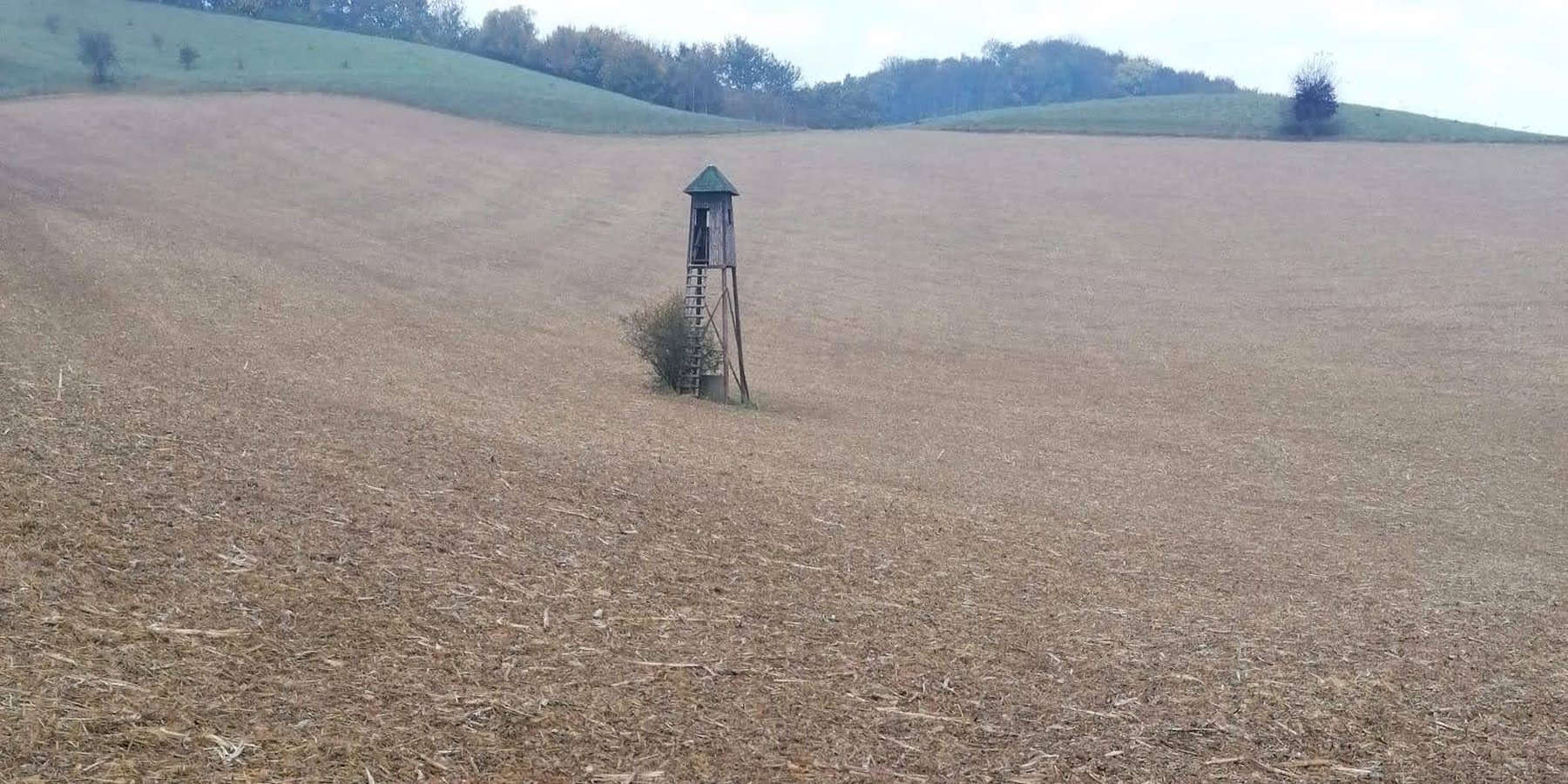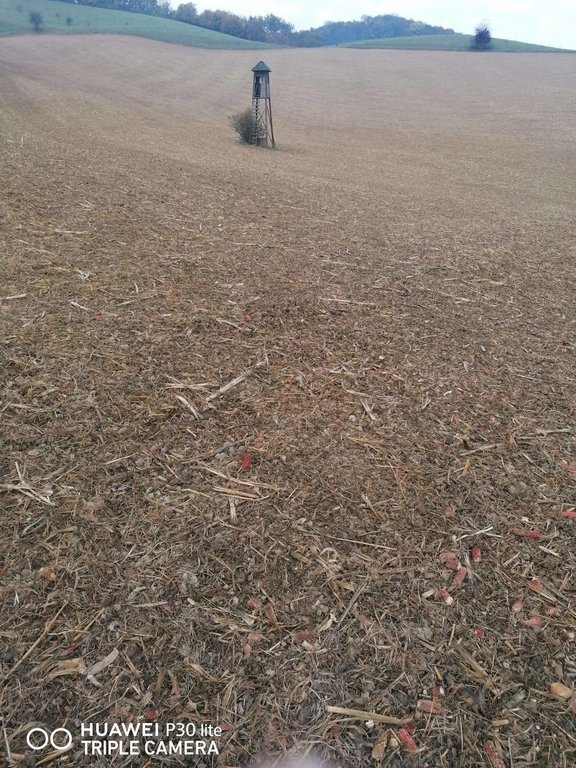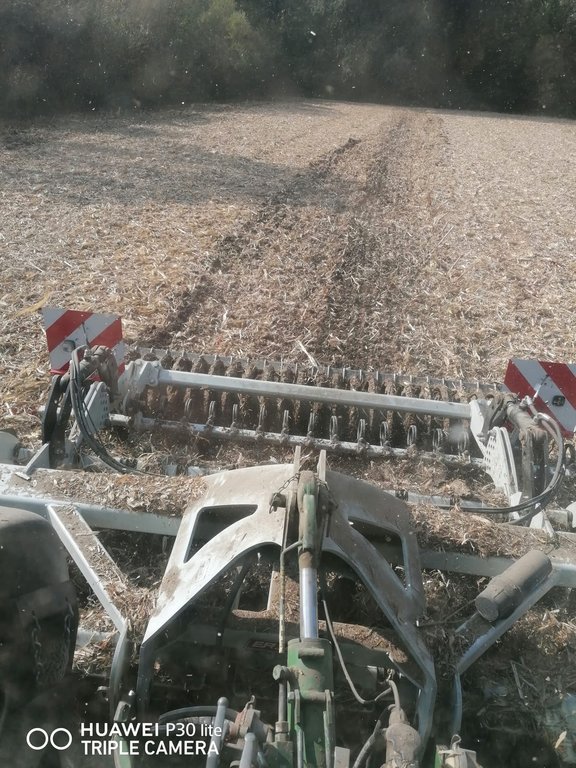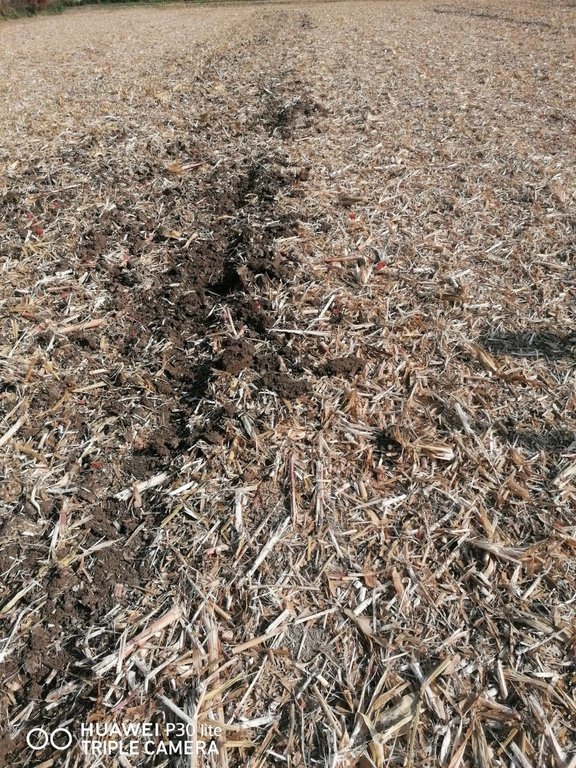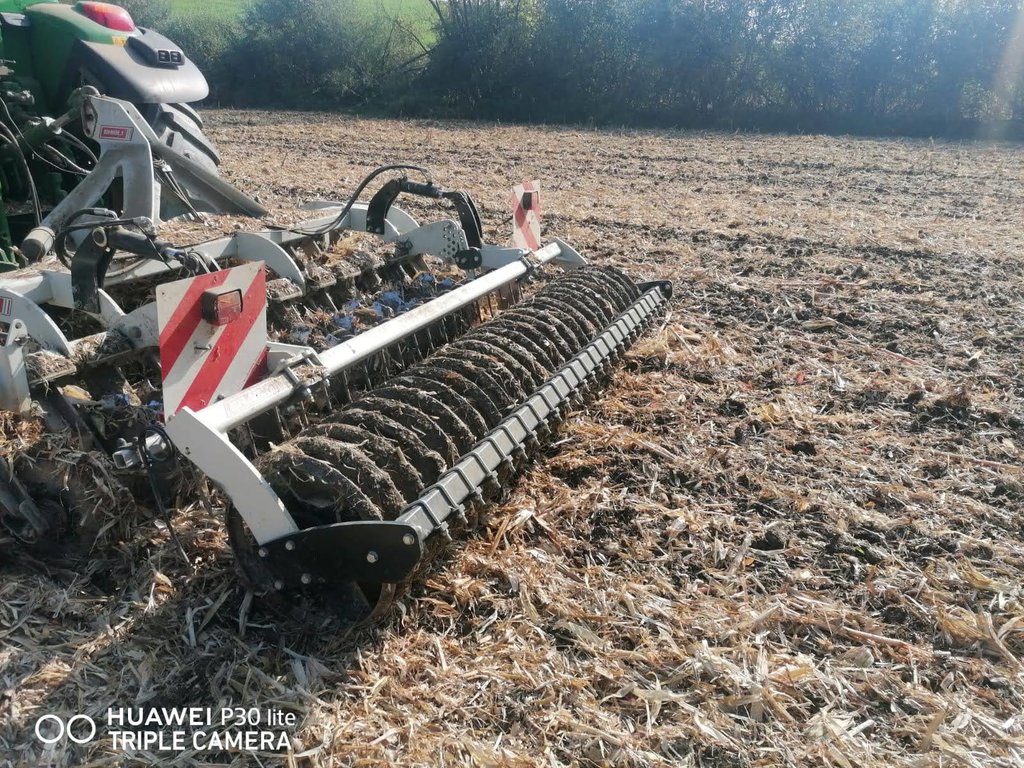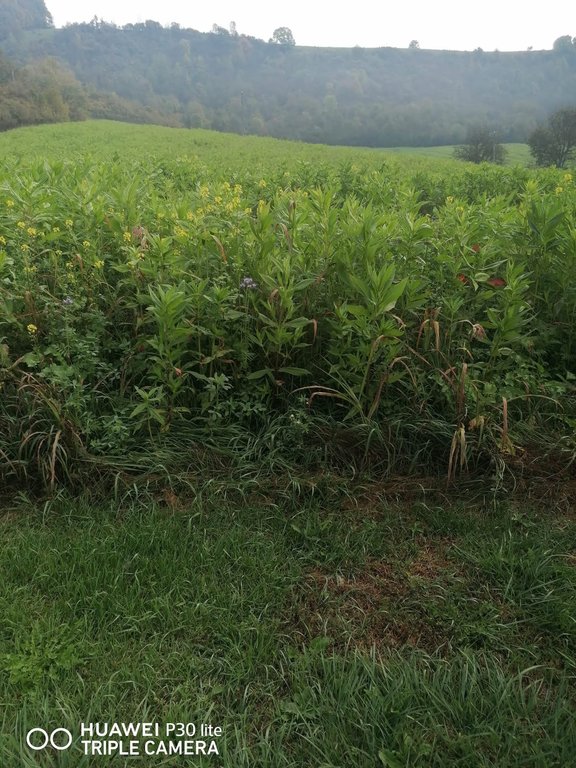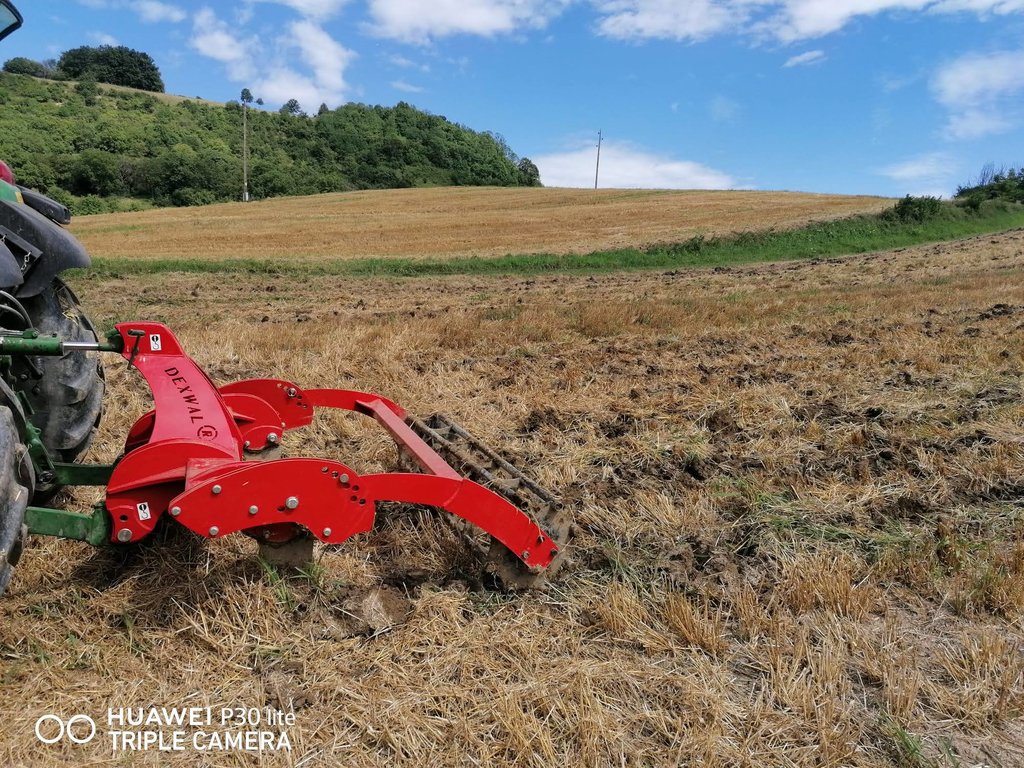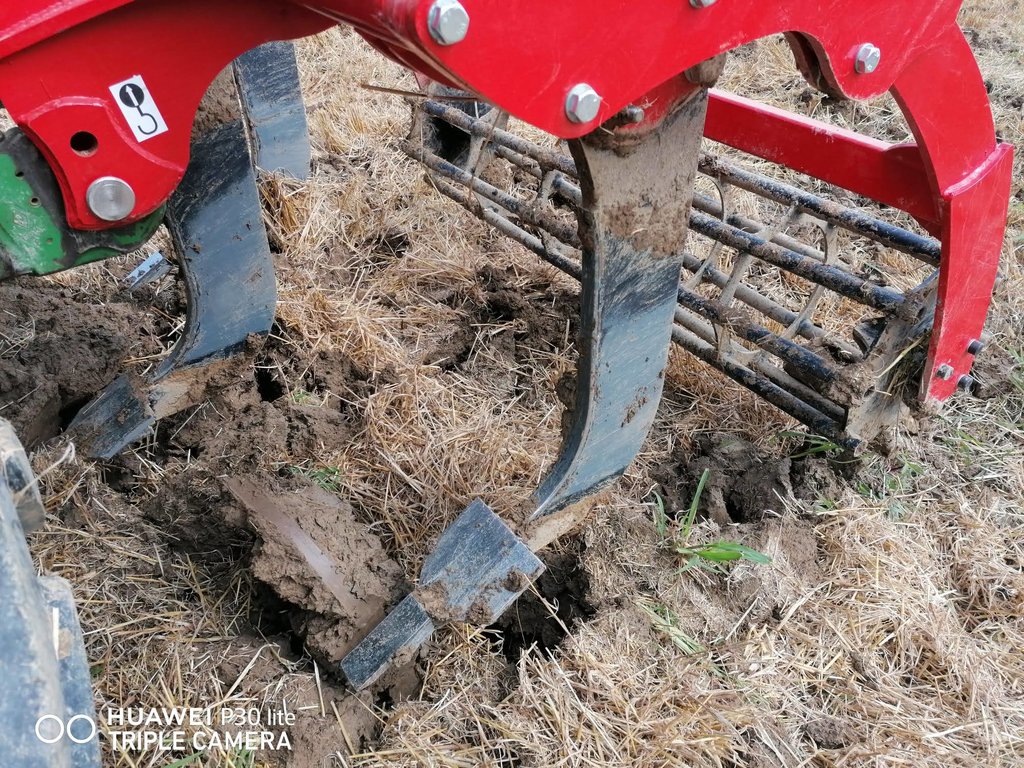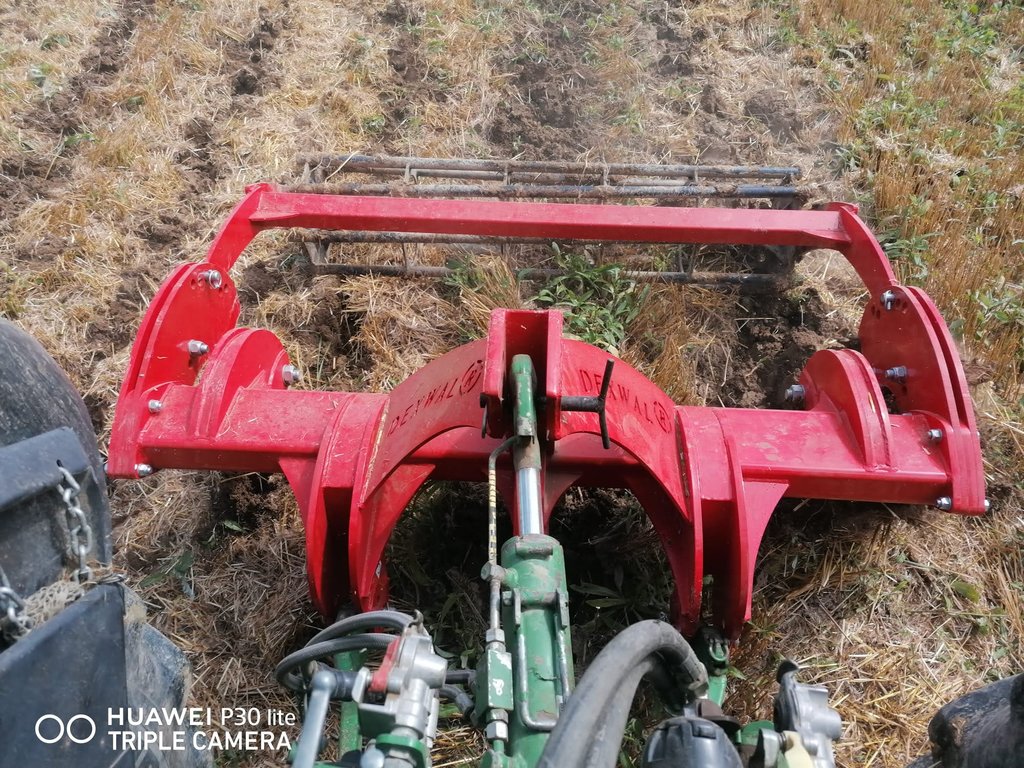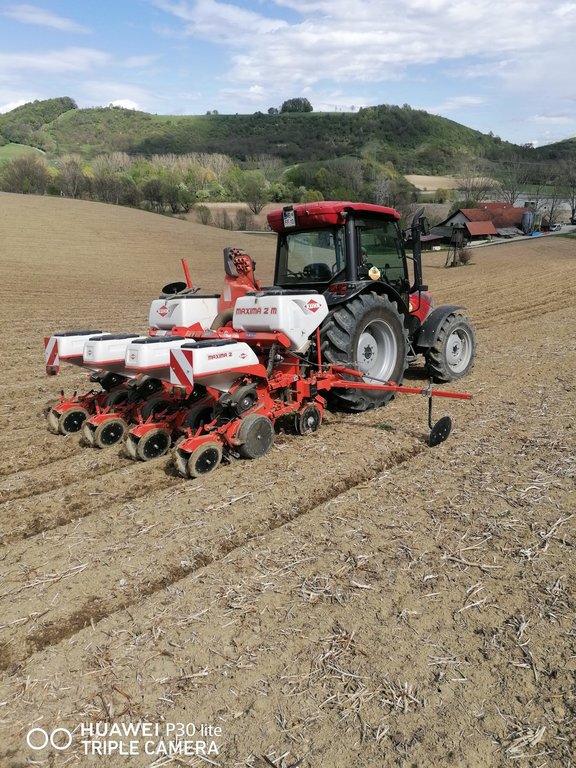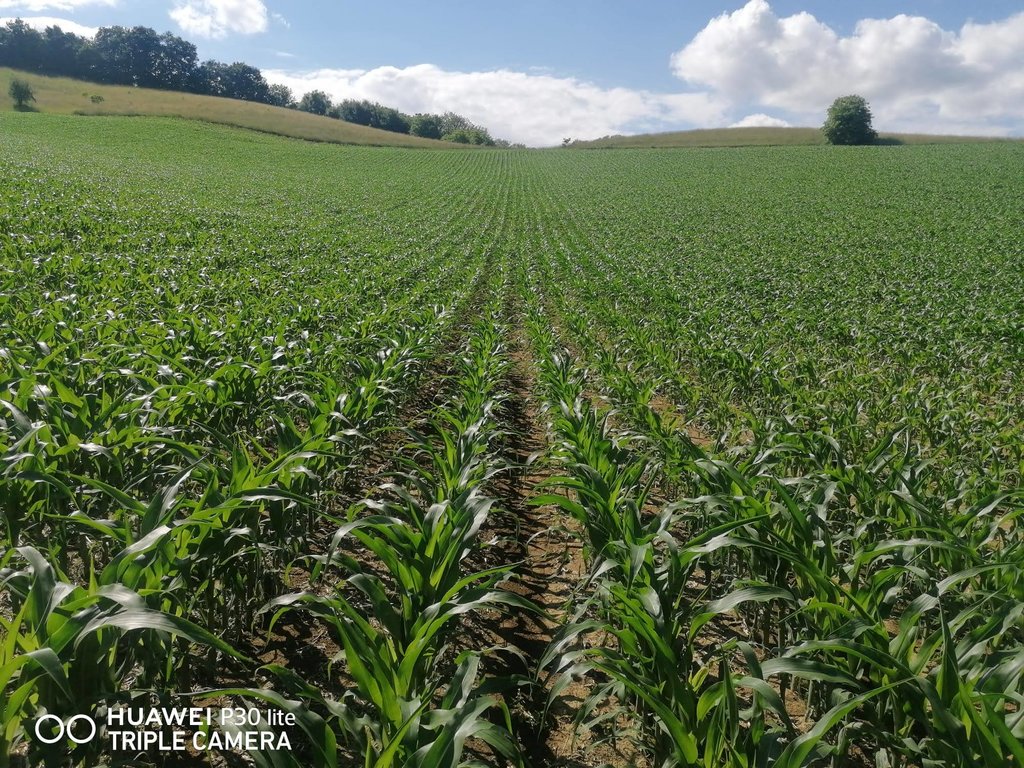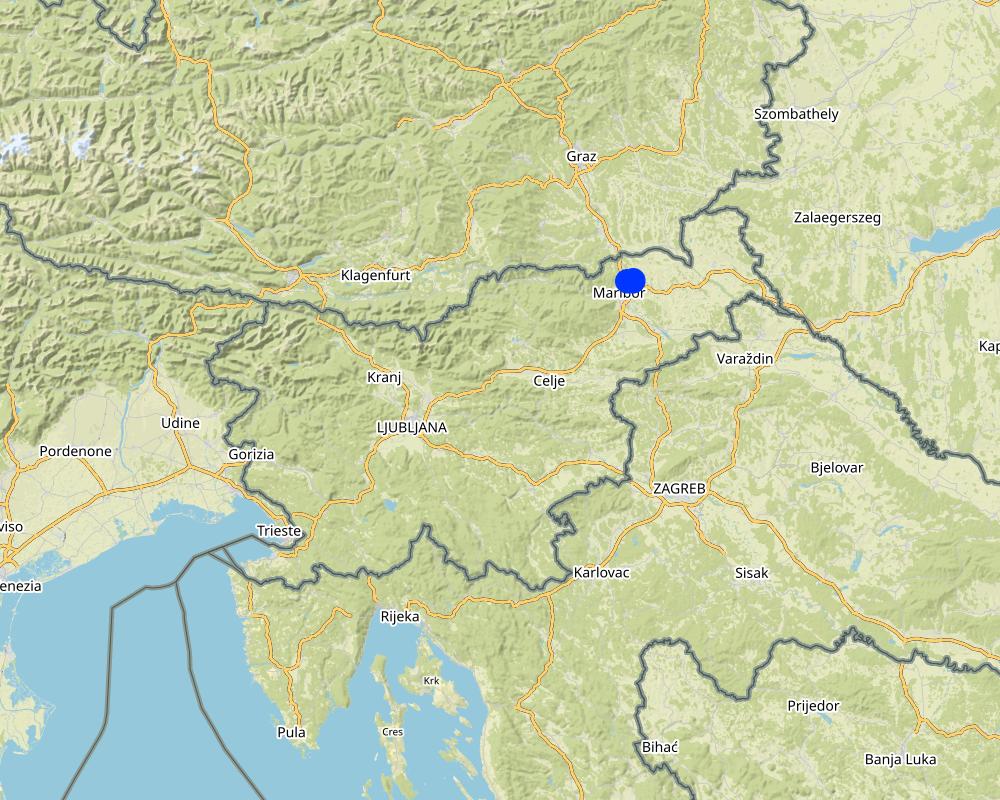Mulch-till [Eslovênia]
- Criação:
- Atualização:
- Compilador/a: Gregor Kramberger
- Editor: Matjaz Glavan
- Revisores: William Critchley, Rima Mekdaschi Studer
Konzervirajoča obdelava tal (mulch-till)
technologies_6241 - Eslovênia
Veja as seções
Expandir tudo Recolher tudo1. Informação geral
1.2 Detalhes do contato das pessoas capacitadas e instituições envolvidas na avaliação e documentação da tecnologia
Especialista em GST:
Especialista em GST:
Curk Miha
Biotechnical Faculty, University of Ljubljana
Eslovênia
Especialista em GST:
Cvejic Rozalija
Biotechnical Faculty, University of Ljubljana
Eslovênia
usuário de terra:
Ropič Andrej
Farmer
Eslovênia
Nome do projeto que facilitou a documentação/avaliação da Tecnologia (se relevante)
OPtimal strategies to retAIN and re-use water and nutrients in small agricultural catchments across different soil-climatic regions in Europe (OPTAIN)Nome da(s) instituição(ões) que facilitou(ram) a documentação/ avaliação da Tecnologia (se relevante)
Chamber of Agriculture and Forestry of Slovenia – Institute of Agriculture and Forestry Maribor (KGZS) - Eslovênia1.3 Condições em relação ao uso da informação documentada através de WOCAT
O/a compilador/a e a(s) pessoa(s) capacitada(s) aceitam as condições relativas ao uso de dados documentados através da WOCAT:
Sim
1.4 Declaração de sustentabilidade da tecnologia descrita
A tecnologia descrita aqui é problemática em relação a degradação da terra de forma que não pode ser declarada uma tecnologia de gestão sustentável de terra?
Não
2. Descrição da tecnologia de GST
2.1 Descrição curta da tecnologia
Definição da tecnologia:
Mulch-till is a method of farming that does not utilise a plough, and thus the soil is not turned over. Furthermore, at least 30% of the cultivated area remains covered with organic residues left over from the previous crop. There are multiple benefits to the soil and carbon dioxide emissions are reduced.
2.2 Descrição detalhada da tecnologia
Descrição:
Mulch-till (also called “conservation agriculture” or “minimum tillage”) is a method of land management with modified, less intensive tillage, where land is covered with plant residues year-round (at least 30% cover) or grass, energy consumption is reduced, and there is less trampling/ compaction of the soil because of fewer machine passes and the protected surface. Under mulch-till, special agricultural machinery and attachments are required. Disc harrows and chisel ploughs are used to loosen the soil, and direct drills are employed for seeding. Ploughs are not used and the soil is not inverted. This method of tillage is intended to maintain soil structure, build up humus, improve nutrient supply and soil moisture, increase soil microbiological activity and also to prevent soil erosion. Mulch-till reduces the number of work operations on the cultivated area. Because the soil is disturbed less, this minimises the exposure of soil organic matter to the air, and therefore decreases the formation and release of CO2 to the atmosphere.
The debate over whether ploughing is still necessary has been going on for quite some time. Both mulch-till and ploughing have their advantages as well as disadvantages. Research shows that mulch-till reduces soil erosion and compaction, and this has a significant impact on soil fertility. On the other hand, ploughing better inhibits the spread of weeds and certain types of diseases and pests.
Mulch-till requires complete replacement of machines/tools, and this is a considerable initial investment. Regular annual maintenance of the equipment is needed also. Mulch-till provides full benefits after a number of years, through making sure that minimal soil inversion and organic soil coverage is guaranteed. It also requires good planning of crop rotation, the use of a special seed drill and employment of herbicides after emergence (or surface hoeing). Users mention one advantage being the low costs for tillage, which is less expensive than ploughing, and the reduction of soil erosion on sloping terrain. However, they do not like the high investment for equipment, possible lost of yields and increase in weeds: all tend to arise at the beginning of implementation. Knowledge and experience are required, as the technology is quite demanding, so there are chances of failure.
2.3 Fotos da tecnologia
Observações gerais sobre as fotos:
Mulch tillage technique and sowing of maize at the Ropič farm.
2.5 País/região/locais onde a tecnologia foi aplicada e que estão cobertos nesta avaliação
País:
Eslovênia
Região/Estado/Província:
Jareninski dol, Pernica
Especificação adicional de localização:
Vosek
Especifique a difusão da tecnologia:
- Uniformemente difundida numa área
Se a área precisa não for conhecida, indicar a área aproximada coberta:
- < 0,1 km2 (10 ha)
O(s) local(is) tecnológico(s) está(ão) localizado(s) em uma área permanentemente protegida?
Não
Map
×2.6 Data da implementação
Indique o ano de implementação:
2020
2.7 Introdução da tecnologia
Especifique como a tecnologia foi introduzida:
- atráves de inovação dos usuários da terra
- durante experiências/ pesquisa
Comentários (tipos de projeto, etc.):
A few years ago, the farmer transitioned from traditional plowing to a mulch-tillage technique and has been using this method since 2020. In 2021, the farmer sought assistance from a consulting service to connect with the Biotechnical faculty in Ljubljana. Tests were conducted to assess the impact of conservation tillage. Following the positive results, the farmer has continued collaborating with the Biotechnical faculty and the public advisory service, further experimenting with the technology and maintaining the new cultivation approach. Today, he is one of the prominent advocates of conservation tillage.
3. Classificação da tecnologia de GST
3.1 Principal/principais finalidade(s) da tecnologia
- Reduz, previne, recupera a degradação do solo
- Protege uma bacia/zonas a jusante – em combinação com outra tecnologia
- Reduzir riscos de desastre
- Adaptar a mudanças climáticas/extremos e seus impactos
- Atenuar a mudanças climáticas e seus impactos
3.2 Tipo(s) atualizado(s) de uso da terra onde a tecnologia foi aplicada
Uso do solo misturado dentro da mesma unidade de terra:
Não

Terra de cultivo
- Cultura anual
Cultivo anual - Especificar culturas:
- cereais - cevada
- cereais - milho
- cereais - trigo (inverno)
- culturas forrageiras - trevo
- culturas forrageiras - outros
- Legumes e leguminosas - outras
- legumes e leguminosas - soja
Número de estações de cultivo por ano:
- 1
O cultivo entre culturas é praticado?
Não
O rodízio de culturas é praticado?
Sim
Caso afirmativo, especifique:
Continuously 1 main crop: maize, wheat (winter) or barely (winter) and fodder peas or soy. After the main crop, the rotation includes cover crops (greening) which consist of mixtures of plants such as phacelia, clover, mung bean, etc.
3.3 O uso do solo mudou devido à implementação da Tecnologia?
O uso do solo mudou devido à implementação da Tecnologia?
- Não (Continuar com a pergunta 3.4)
3.4 Abastecimento de água
Abastecimento de água para a terra na qual a tecnologia é aplicada:
- Precipitação natural
3.5 Grupo de GST ao qual pertence a tecnologia
- Solo/cobertura vegetal melhorada
- Perturbação mínima ao solo
- Gestão integrada de fertilidade do solo
3.6 Medidas de GST contendo a tecnologia

Medidas agronômicas
- A1: cobertura vegetal/do solo
- A2: Matéria orgânica/fertilidade do solo
- A3: Tratamento da superfície do solo
- A6: Gerenciamento de resíduos
A3: Diferenciar os sistemas de lavoura:
A 3.2: Reduced tillage (> 30% soil cover)
A6: Especificar o gerenciamento de resíduos:
A 6.4: retido
3.7 Principais tipos de degradação da terra abordados pela tecnologia

Erosão do solo pela água
- Wt: Perda do solo superficial/erosão de superfície
- Wg: Erosão por ravinas/ravinamento

Deteriorização química do solo
- Cn: declínio de fertilidade e teor reduzido de matéria orgânica (não causado pela erosão)

Deteriorização física do solo
- Pc: Compactação

Degradação biológica
- Bc: redução da cobertura vegetal
- Bq: quantidade/ declínio da biomassa
- Bl: perda da vida do solo
3.8 Redução, prevenção ou recuperação da degradação do solo
Especifique o objetivo da tecnologia em relação a degradação da terra:
- Prevenir degradação do solo
- Reduzir a degradação do solo
4. Especificações técnicas, implementação de atividades, entradas e custos
4.1 Desenho técnico da tecnologia
Especificações técnicas (relacionada ao desenho técnico):
Whether it is low-till or conventional tillage depends on the tool use during soil tillage and how we use it. There are many implementation variants of conservation tillage that go by different professional names and definitions. Low-till is defined according to the depth of tillage, the intensity of soil layer mixing, the coverage of soil surface with harvest (organic) residues or intermediate tillage residues, according to the way tools move on the soil and the number of machine operations that are performed individually or combined (basic tillage, soil loosening seedbed preparation, pre-sowing tillage, sowing, ...). We focus on one version of low-till that we estimate has the greatest chances of being established in a short time in the case study area, which is so called »mulch-till«. We will concentrate on the term »mulch-till« which we define as a medium deep (10 cm) conservation tillage technique using chisel plow in combination with disk harrow. The coverage of the soil surface with residues must be at least 30% or higher. In addition, a special seeder is required to carry out "mulch" sowing (with moving parts). The success of mulch-till also depends on the combination with other implemented measures like crop rotation, cover crops, etc.
Autor:
Bodenbear beitung und Bestellung
Data:
2015
4.2 Informação geral em relação ao cálculo de entradas e custos
Especifique como custos e entradas foram calculados:
- por área de tecnologia
Indique o tamanho e a unidade de área:
1 ha
Se utilizar uma unidade de área local, indicar fator de conversão para um hectare (por exemplo, 1 ha = 2,47 acres): 1 ha =:
1 ha = 10,000 m2
Outro/moeda nacional (especifique):
EUR
Se for relevante, indique a taxa de câmbio do USD para moeda local (por exemplo, 1 USD = 79,9 Real): 1 USD =:
0,97
Indique a média salarial da mão-de-obra contratada por dia:
90.90
4.3 Atividades de implantação
| Atividade | Periodicidade (estação do ano) | |
|---|---|---|
| 1. | Purchase of 2-row disc harrow | 1st year |
| 2. | Purchase deep chisel plow | 1st year |
| 3. | Purchase pneumatic seed drill combined with rotary harrow | 1st year |
| 4. | Purchase pneumatic precision planter with rotating elements | 1st year |
| 5. | Purchase cover crop seed drill | 1st year |
Comentários:
Tractor should also be considered as part of the investment in implementing the mulch-till technology. The required tractor for operating Mulch-till is at least 110 HP. Let's assume a tractor with four-wheel drive, 95–125 kW (129–170 HP), with an investment cost of 66,400 €. Its usage should be economically justified for the entire farm (used for all farm tasks).
4.4 Custos e entradas necessárias para a implantação
| Especifique a entrada | Unidade | Quantidade | Custos por unidade | Custos totais por entrada | % dos custos arcados pelos usuários da terra | |
|---|---|---|---|---|---|---|
| Equipamento | Purchase of 2-row disc harrow | piece | 29,7 | 404,0404 | 12000,0 | 100,0 |
| Equipamento | Purchase deep chisel plow | piece | 29,7 | 101,0101 | 3000,0 | 100,0 |
| Equipamento | Pneumatic seed drill combined with rotary harrow | piece | 29,7 | 909,0909 | 27000,0 | 100,0 |
| Equipamento | Pneumatic precision planter with rotating elements | piece | 29,7 | 572,3905 | 17000,0 | 100,0 |
| Equipamento | Cover crop seed drill | piece | 29,7 | 151,5151 | 4500,0 | 100,0 |
| Custos totais para a implantação da tecnologia | 63500,0 | |||||
| Custos totais para o estabelecimento da Tecnologia em USD | 65463,92 | |||||
Comentários:
The estimated lifespan of the equipment represents only an illustrative measure in terms of total hours, hectares, or machine work until its obsolescence. This data is not considered in the cost calculation. It is generally not economically viable to use a machine until its complete obsolescence, as it may become technologically outdated or require excessive investment for restoration compared to its economic usage. It is more sensible to use the machine's depreciation period. The average depreciation value is determined based on the average annual usage of the machine. The depreciation period for attachments is 12 years.
4.5 Atividades recorrentes/manutenção
| Atividade | Periodicidade/frequência | |
|---|---|---|
| 1. | Tractor operation and maintanance | It is used for all operations related to the technology (without cover crop seed drill operation).. |
| 2. | Deep chisel plow operation and maintanance | 1 time per 5 years, on all cultivated field surfaces (29,7 ha), 1.0 h/ha. |
| 3. | 2-row disc harrow operation and maintanance | 2 time per year, on all cultivated field surfaces (29,7 ha), 0.8 h/ha. |
| 4. | Pneumatic precision planter with rotating elements operation and maintanance | 1 times per year, on 50 % of all cultivated field surfaces (14.85 ha), 1.3 h/ha. |
| 5. | Cover crop seed drill operation and maintanance | 1 time per year, on all cultivated field surfaces (29,7 ha), 0.8 h/ha (combined with harrow). |
| 6. | Pneumatic seed drill combined with rotary harrow operation and maintanance | 1 times per year, on 50 % of all cultivated field surfaces (14,85 ha), 1.4 h/ha. |
| 7. | Purchase cover crop seed mixture Fruh | 1 time per year, on all cultivated field surfaces (29,7 ha). |
4.6 Custos e entradas necessárias pata a manutenção/atividades recorrentes (por ano)
| Especifique a entrada | Unidade | Quantidade | Custos por unidade | Custos totais por entrada | % dos custos arcados pelos usuários da terra | |
|---|---|---|---|---|---|---|
| Mão-de-obra | Tractor operation | EUR/ha | 29,7 | 18,144 | 538,88 | 100,0 |
| Mão-de-obra | Machine maintenance | EUR/ha | 29,7 | 2,88 | 85,54 | 100,0 |
| Equipamento | Machine avarage total costs of tractor operation and maintanance | EUR/ha | 29,7 | 122,598 | 3641,16 | 100,0 |
| Equipamento | Machine avarage total costs of deep chisel plow operation and maintanance | EUR/ha | 29,7 | 4,36 | 129,49 | 100,0 |
| Equipamento | Machine avarage total costs of 2-row disc harrow operation and maintanance | EUR/ha | 29,7 | 30,432 | 903,83 | 100,0 |
| Equipamento | Machine avarage total costs of pneumatic precision planter with rotating elements operation and maintanance | EUR/ha | 14,85 | 29,744 | 441,7 | 100,0 |
| Equipamento | Machine avarage total costs of cover crop seed drill operation and maintanance | EUR/ha | 29,7 | 2,872 | 85,3 | 100,0 |
| Equipamento | Machine avarage total costs of Pneumatic seed drill combined with rotary harrow operation and maintanance | EUR/ha | 14,85 | 52,416 | 778,38 | 100,0 |
| Material vegetal | Cover crop mixture Fruh | EUR/ha | 29,7 | 66,768 | 1983,01 | 100,0 |
| Custos totais para a manutenção da tecnologia | 8587,29 | |||||
| Custos totais de manutenção da Tecnologia em USD | 8852,88 | |||||
4.7 Fatores mais importantes que afetam os custos
Descreva os fatores mais determinantes que afetam os custos:
It very much depends on the type of soil, what is the structure of the soil. In addition, the planning of the crop rotation and cover crops also affect the costs. As a result, weed development and subsequent herbicide use may be different.
5. Ambiente natural e humano
5.1 Clima
Precipitação pluviométrica anual
- <250 mm
- 251-500 mm
- 501-750 mm
- 751-1.000 mm
- 1.001-1.500 mm
- 1.501-2.000 mm
- 2.001-3.000 mm
- 3.001-4.000 mm
- > 4.000 mm
Especifique a média pluviométrica anual em mm (se conhecida):
1015,00
Especificações/comentários sobre a pluviosidade:
The most precipitation falls in summer, the months with the highest average precipitation are June and August, the least precipitation falls in winter, in January and February at least, and in principle more precipitation falls in autumn than in spring.
Indique o nome da estação meteorológica de referência considerada:
Jareninski vrh (1981 – 2010)
Zona agroclimática
- Subúmido
Mean annual temperature in year 2014 Jareninski vrh is 11,9°C.
5.2 Topografia
Declividade média:
- Plano (0-2%)
- Suave ondulado (3-5%)
- Ondulado (6-10%)
- Moderadamente ondulado (11-15%)
- Forte ondulado (16-30%)
- Montanhoso (31-60%)
- Escarpado (>60%)
Formas de relevo:
- Planalto/planície
- Cumes
- Encosta de serra
- Encosta de morro
- Sopés
- Fundos de vale
Zona de altitude:
- 0-100 m s.n.m.
- 101-500 m s.n.m.
- 501-1.000 m s.n.m.
- 1.001-1.500 m s.n.m.
- 1.501-2.000 m s.n.m.
- 2.001-2.500 m s.n.m.
- 2.501-3.000 m s.n.m.
- 3.001-4.000 m s.n.m.
- > 4.000 m s.n.m.
Indique se a tecnologia é aplicada especificamente em:
- Posições côncavas
Comentários e outras especificações sobre a topografia:
There are depressions, settlements are in the valley, concave type.
5.3 Solos
Profundidade do solo em média:
- Muito raso (0-20 cm)
- Raso (21-50 cm)
- Moderadamente profundo (51-80 cm)
- Profundo (81-120 cm)
- Muito profundo (>120 cm)
Textura do solo (solo superficial):
- Médio (limoso, siltoso)
Textura do solo (>20 cm abaixo da superfície):
- Médio (limoso, siltoso)
Matéria orgânica do solo superficial:
- Médio (1-3%)
5.4 Disponibilidade e qualidade de água
Lençol freático:
5-50 m
Disponibilidade de água de superfície:
Bom
Qualidade da água (não tratada):
apenas para uso agrícola (irrigação)
A qualidade da água refere-se a:
água de superfície
A salinidade da água é um problema?
Não
Ocorre inundação da área?
Sim
Regularidade:
Esporadicamente
Comentários e outras especificações sobre a qualidade e a quantidade da água:
Hydromelioration was carried out in the area, a drainage system and water retention systems (e.g. ponds and basins) were arranged.
5.5 Biodiversidade
Diversidade de espécies:
- Médio
Diversidade de habitat:
- Médio
5.6 Características dos usuários da terra que utilizam a tecnologia
Sedentário ou nômade:
- Sedentário
Orientação de mercado do sistema de produção:
- Comercial/mercado
Rendimento não agrícola:
- 10-50% de toda renda
Nível relativo de riqueza:
- Média
Indivíduos ou grupos:
- Indivíduo/unidade familiar
Nível de mecanização:
- Mecanizado/motorizado
Gênero:
- Homens
Idade dos usuários da terra:
- meia-idade
5.7 Área média de terrenos utilizados pelos usuários de terrenos que aplicam a Tecnologia
- < 0,5 ha
- 0,5-1 ha
- 1-2 ha
- 2-5 ha
- 5-15 ha
- 15-50 ha
- 50-100 ha
- 100-500 ha
- 500-1.000 ha
- 1.000-10.000 ha
- > 10.000 ha
É considerado pequena, média ou grande escala (referente ao contexto local)?
- Média escala
5.8 Propriedade de terra, direitos de uso da terra e de uso da água
Propriedade da terra:
- Indivíduo, intitulado
Direitos do uso da terra:
- Arrendado
- Indivíduo
Direitos do uso da água:
- Comunitário (organizado)
Os direitos de uso da terra são baseados em um sistema jurídico tradicional?
Não
Especifique:
based on national legal system
5.9 Acesso a serviços e infraestrutura
Saúde:
- Pobre
- Moderado
- Bom
Educação:
- Pobre
- Moderado
- Bom
Assistência técnica:
- Pobre
- Moderado
- Bom
Emprego (p. ex. não agrícola):
- Pobre
- Moderado
- Bom
Mercados:
- Pobre
- Moderado
- Bom
Energia:
- Pobre
- Moderado
- Bom
Vias e transporte:
- Pobre
- Moderado
- Bom
Água potável e saneamento:
- Pobre
- Moderado
- Bom
Serviços financeiros:
- Pobre
- Moderado
- Bom
6. Impactos e declarações finais
6.1 Impactos no local mostrados pela tecnologia
Impactos socioeconômicos
Produção
Produção agrícola
Comentários/especificar:
Some farmers report a slight drop in yield in first years after the implementation of the measure, but the farmer in the case study location didn't notice any difference in yield.
Risco de falha de produção
Comentários/especificar:
Reduced risk, but with the wrong approach it can increase. For example, reduced risk due to unfavorable weather conditions, increased risk due to the possibility of weed development.
Gestão de terra
Comentários/especificar:
Simplified soil tillage technology.
Renda e custos
Despesas com insumos agrícolas
Comentários/especificar:
Reduced costs due to lower energy (fuel) consumption.
Carga de trabalho
Comentários/especificar:
Fewer hours dedicated for tillage.
Impactos socioculturais
Segurança alimentar/auto-suficiência
Comentários/especificar:
Facilitated production with lower costs, motivation to do business in agriculture.
Conhecimento de GST/ degradação da terra
Comentários/especificar:
With positive effects more interest of the farmer in sustainable production.
Impactos ecológicos
Ciclo hídrico/escoamento
Escoamento superficial
Evaporação
Solo
Umidade do solo
Cobertura do solo
Perda de solo
Acumulação de solo
Ressecamento/ selagem do solo
Compactação do solo
Ciclo e recarga de nutrientes
Matéria orgânica do solo/carbono abaixo do solo
Biodiversidade: vegetação, animais
Cobertura vegetal
Biomassa/carbono acima do solo
Diversidade vegetal
Espécies exóticas invasoras
Diversidade animal
Comentários/especificar:
Cover crops act as hiding places for various animals.
Espécies benéficas
Comentários/especificar:
Plants attract pollinators.
Diversidade de habitat
Clima e redução de riscos de desastre
Impactos da seca
Emissão de carbono e gases de efeito estufa
6.2 Impactos externos mostrados pela tecnologia
Capacidade de tamponamento/filtragem
Comentários/especificar:
Surface cover with plants.
Danos na infraestrutura pública/privada
Comentários/especificar:
The soil is not carried into ditches and ponds.
6.3 Exposição e sensibilidade da tecnologia às mudanças climáticas graduais e extremos/desastres relacionados ao clima (conforme o ponto de vista dos usuários da terra)
Mudança climática gradual
Mudança climática gradual
| Estação do ano | aumento ou diminuição | Como a tecnologia lida com isso? | |
|---|---|---|---|
| Precipitação pluviométrica anual | redução/diminuição | bem |
Extremos (desastres) relacionados ao clima
Desastres meteorológicos
| Como a tecnologia lida com isso? | |
|---|---|
| Temporal local | muito bem |
Desastres climatológicos
| Como a tecnologia lida com isso? | |
|---|---|
| Onde de calor | bem |
| Seca | bem |
Desastres hidrológicos
| Como a tecnologia lida com isso? | |
|---|---|
| Deslizamento de terra | muito bem |
6.4 Análise do custo-benefício
Como os benefícios se comparam aos custos de implantação (do ponto de vista dos usuários da terra)?
Retornos a curto prazo:
levemente negativo
Retornos a longo prazo:
positivo
Como os benefícios se comparam aos custos recorrentes/de manutenção(do ponto de vista dos usuários da terra)?
Retornos a curto prazo:
positivo
Retornos a longo prazo:
positivo
Comentários:
The initial establishment and investment costs for implementing the technology are high, and in the short term, the benefits may not be very noticeable or even negative compared to conservative technology. However, the long-term benefits are more significant and positive. While there are recurring costs involved, such as maintenance expenses, they are considerably lower compared to the initial investment costs. The technology requires substantial upfront investment in equipment, which can initially outweigh the immediate returns. It takes time for the technology to mature and for the full benefits to be realized. As the system becomes established and optimized, the positive outcomes become more apparent over the long run. Additionally, the lower costs mentioned refer to the ongoing maintenance and operational expenses required to sustain the technology (machines), which are generally lower than the initial investment costs. These costs are often outweighed by the benefits gained from improved efficiency, reduced resource consumption, and other long-term advantages. Therefore, while the short-term returns may not be overwhelmingly positive, the investment in the technology pays off over time, with greater benefits and lower operational costs.
6.5 Adoção da tecnologia
- 1-10%
De todos aqueles que adotaram a Tecnologia, quantos o fizeram espontaneamente, ou seja, sem receber nenhum incentivo/ pagamento material?
- 91-100%
6.6 Adaptação
A tecnologia foi recentemente modificada para adaptar-se as condições variáveis?
Sim
Outros (especificar):
added equipment/mechanization attachments to facilitate technology implementation, improved technology implementation with knowledge and experience
Especifique a adaptação da tecnologia (desenho, material/espécie, etc):
Added cover crop seed drill. more emphasis on cover crop.
6.7 Pontos fortes/vantagens/oportunidades da tecnologia
| Pontos fortes/vantagens/oportunidades na visão do usuário da terra |
|---|
| Less depression, erosion and soil leaching. |
| Cost and time (fewer passes, machine hours, less machine power required). |
| Care for nature, sustain natural resources. |
| Pontos fortes/vantagens/oportunidades na visão do/a compilador/a ou de outra pessoa capacitada |
|---|
| In the long term it enables the achievement of better soil conditions, in terms of appropriate ratios of water, air, nutrients, organic matter, microbial activity, pH, microbial activity, pH and other factors of soil fertility. |
| Compaction and drying of the top layer of the soil is significantly less frequent and as a result losses of young plants are therefore smaller. |
| It reduces the potential for soil erosion. A major threat to soil fertility is erosion processes (wind, water and other erosion), where the most fertile surface layers of the soil are carried away to other parts of the ecosystem that are not intended for food production. |
| It brings advantages in terms of energy consumption and the possibility of carrying out production tasks in a shorter time and in difficult weather conditions. Conservation tillage tools typically operate in a shallower soil layer and mix less soil mass, it enables the use of tools with larger working widths and thus less unproductive driving in the field. |
| Benefits in terms of reduced transfer of phytopharmaceuticals and nutrients excess from the cultivation area to water and other ecosystems. |
| Reduced tillage improves soil quality, reduces nutrient leaching and lowers greenhouse gas emissions. |
| Benefits in terms of bioavailability and nutrient uptake efficiency. |
| Benefits in terms of greater adaptability of crops to extreme weather events. |
| Benefits in terms of maintaining the overall biological diversity of the agricultural landscape and soil. |
6.8 Pontos fracos, desvantagens/riscos da tecnologia e formas de superá-los
| Pontos fracos/desvantagens/riscos na visão do usuário da terra | Como eles podem ser superados? |
|---|---|
| A big investment in machinery. | It is possible to start gradually with cheaper and simpler machines (also home-made). |
| Adaptation of crop protection. | Implementing integrated pest management (IPM). |
| Pontos fracos/vantagens/riscos na visão do/a compilador/a ou de outra pessoa capacitada | Como eles podem ser superados? |
|---|---|
| An increase in the occurrence of certain types of weeds and a high dependence on certain types of herbicides. Some studies show that the introduction of conservation tillage slightly increases losses from certain diseases and pests. | For successful weed control, it is important to have a varied crop rotation, frequent sowing of cover crops and intercrops, and that the weeds never leave uncontrolled development on the stubble. The variegated crop rotation is meant as an obstacle that interrupts the development cycle of diseases and pests. How we handle harvest residues is also important. The more finely they are chopped by combines, mulchers or tools for vertical tillage before sowing, the faster they decompose and the worse the chances of harmful organisms developing on them. An evenly distributed mulch of harvest residues should remain, which prevents the emergence of new waves of weeds. These additional measures, together with mechanical weed control with new types of tools, allow limiting the weed population to a level that can be controlled with a limited range of herbicides. |
| Investment costs in machines designed for the method of soil cultivation can be very high. An important obstacle in the introduction of conservation tillage is the large investments in new machinery... The value of purchasing these tools can well exceed the amount of 100,000 euros for an individual farm, which is a practically unfeasible investment for small farms. | Small farms can take the transition to conservation farming only with the help of hired machinery services from neighbouring large farms that have been able to invest in new equipment. The subsidization of the purchase of machinery and also the economic legal status of the farm in terms of VAT calculation play an important role. |
| It is necessary to replace all the tools used by farmers according to the old methods of tillage. It is necessary to purchase adapted cultivators, harrows, looseners and especially seeder drills. | Increase in the supply of relatively inexpensive machines from manufacturers from Eastern Europe and Turkey, which can increase the availability of this equipment to smaller farms. |
| In the first years of the transition period, there may be a significant reduction in yields and poor financial results. There is a yield reduction and financial stress during the transition period to the new system. The transition from conventional cultivation to conservation tillage is usually difficult and risky. | Growers must be financially strong in order to make the transition, and the areas under alternative cultivation systems must increase gradually when they really master the new cultivation technique. Good financial support during the transition period is very important for small farms with weak investment assets. Targeted education and training is necessary, as technological errors due to lack of knowledge regarding the implementation of conservation cultivation in different soil types can be economically very fatal. |
| A small increase in the seeding rate (10 to 15 %) is often recommended to compensate for losses caused by diseases and pests at the time of plant emergence. | A necessary cost that must be accepted (higher sowing rate for the main crops and additional crops – cover crops) for the successful implementation of the measure. |
7. Referências e links
7.1 Métodos/fontes de informação
- entrevistas com usuários de terras
1 farmer (Andrej Ropič)
- entrevistas com especialistas em GST
3 (Biotechnical Faculty; Matjaž Glavan, Miha Curk, and Rozalija Cvejič)
- compilação de relatórios e outra documentação existente
2 (we utilized the following documents: "ANALYSIS OF ECONOMIC EFFICIENCY OF ALTERNATIVE AGRONOMIC PRACTICE (AAP) ON VVO" by Črtomir Rozman, Karmen Pažek, Mario Lešnik, and "Bodenbearbeitung und Bestellung Definition von Bodenbearbeitungs- und Bestellsystemen" (translated to English as "Tillage and cultivation Definition of tillage and cultivation systems") by Dr. Joachim Bischoff et al.)
Quando os dados foram compilados (no campo)?
17/01/2023
Comentários:
Visit to the farm and farmer interview. A working group was established, where we met 2 times to review and respond to the questionnaire.
7.2 Referências às publicações disponíveis
Título, autor, ano, ISBN:
TJ Townsend, SJ Ramsden, P Wilson. Analysing reduced tillage practices within a bio-economic modelling framework. Agricultural Systems 146 (2016) 91–102.
Disponível de onde? Custos?
ScienceDirect
Título, autor, ano, ISBN:
E Houshyar, MJ SheikhDavoodi, M Almassi, H Bahrami, H Azadi, M Omidi, G Sayyad, F Witlox. Silage corn production in conventional and conservation tillage systems. Part I: Sustainability analysis using combination of GIS/AHP and multi-fuzzy modeling. Ecological Indicators 39 (2014) 102–114.
Disponível de onde? Custos?
ScienceDirect
7.3 Links para informações on-line relevantes
Título/ descrição:
C Rozman, K Pažek, M Lešnik. Analiza ekonomske ucinkovitosti alternativne agronomske prakse (AAP) na VVO. Univerza v Mariboru, Fakulteta za kmetijstvo in biosistemske vede, 2018.
URL:
https://www.google.com/url?sa=t&rct=j&q=&esrc=s&source=web&cd=&ved=2ahUKEwjNtpH7peD8AhWFzaQKHdPXBM4QFnoECAYQAQ&url=https%3A%2F%2Fwww.kgzs-ms.si%2Fwp-content%2Fuploads%2F2018%2F07%2FD.T3.3.1-Study-final-May-2018.pdf&usg=AOvVaw3qni6nXmwUM25mhI0FwPln
Título/ descrição:
Mimalna obdelava tal – praktični primeri na naših kmetijah (žipo, ropic, horvat)
URL:
https://www.google.com/url?sa=t&rct=j&q=&esrc=s&source=web&cd=&cad=rja&uact=8&ved=2ahUKEwiZ6smRpuD8AhWrsaQKHcRSBoMQFnoECAkQAQ&url=https%3A%2F%2Fwww.kmetijski-zavod.si%2FPortals%2F0%2Flombergarjevi%2FMinimalna%2520obdelava%2520tal%2520%25E2%2580%2593%2520prakti%25C4%258Dni%2520primeri%2520na%2520na%25C5%25A1ih%2520kmetijah%2520%5BSamodejno%2520shranjeno%5D.pdf%3Fver%3D2021-12-13-094249-623&usg=AOvVaw1jtWGuL4ovgrvC0rvqm1iS
Links e módulos
Expandir tudo Recolher tudoLinks
Não há links
Módulos
Não há módulos


